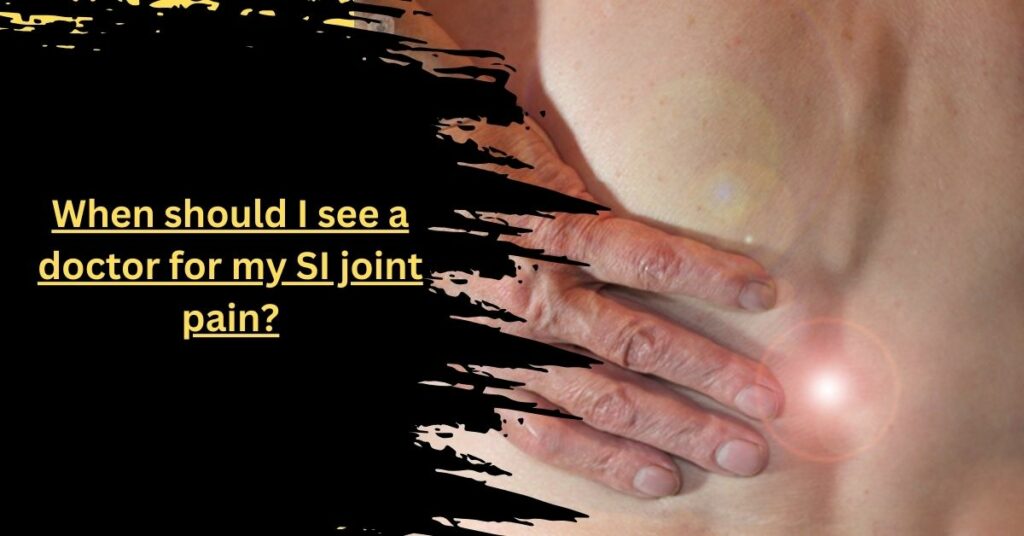If you are experiencing pain in your lower back, hips, or buttocks, you may suffer from SI joint pain. The sacroiliac (SI) joint is located at the bottom of your spine and connects the sacrum to the ilium bones in your pelvis.
It transfers weight and movement between your upper body and legs. Here are signs that indicate you need to see a pain management dr for your SI joint pain:
Persistent or Worsening Pain
The worsening of SI joint pain is a sign of underlying medical issues such as arthritis, nerve irritation, or inflammation. The duration, severity, and frequency of the pain help determine the underlying causes. A professional assessment is required to treat these underlying issues.
A pain management doctor evaluates the condition to find appropriate treatment and prevent further damage. They can also prescribe medications based on the severity of your pain to help manage symptoms.
Limited Range of Motion
SI joint pain causes stiffness and limited range of motion in the lower back, hips, and thighs. The sacroiliac (SI) joint targets muscle groups and affects your ability to perform simple tasks such as walking, sitting, or bending.
People who experience chronic lower back pain also find difficulty moving about comfortably. Exercise, physical therapy, and medications help improve the range of motion. A pain management dr develops a personalized treatment plan to address your specific condition and improve mobility.
Difficulty Sleeping
The average sleep cycle consists of four stages, including a deep sleep stage, during which the body repairs and rejuvenates itself. SI joint pain interferes with your ability to fall asleep, leading to disturbed or insufficient rest.
This causes fatigue, irritability, and reduced productivity during the day. Certain sleeping positions, the use of pillows or mattresses designed for back pain, and relaxation techniques provide relief.
Lower back exercises and stretches taught by a physical therapist may also help reduce pain and promote better sleep. Activity training helps find the right balance between rest and movement to manage pain effectively.
Weakness or Instability
Feeling weak or unsteady in your pelvis or lower back, which can impact balance or walking, indicates SI joint issues. The SI joint connects the pelvic bones to the spine and supports the upper body’s weight. When this joint is inflamed, it causes weakness or instability in these areas.
Physical therapy exercises that focus on strengthening the muscles around the SI joint help improve stability and reduce pain. Your doctor may also recommend using supportive braces or orthotic devices to provide extra stability and support during daily activities.
Leg Numbness or Tingling
Leg numbness occurs when there is a lack of sensation or feeling in the leg due to nerve compression or irritation. A thorough healthcare evaluation can differentiate whether numbness is linked to SI joint dysfunction for accurate diagnosis.
Treatment options include physical therapy, nerve blocks, or surgery if the numbness is severe and impacting daily activities. Tingling sensations affect the nerves by sending a prickling or burning sensation through the leg.
This is often caused by nerve impingement, which occurs when there is inflammation or pressure on the nerves in the lower back. Gentle stretching and strengthening exercises prescribed by a physical therapist help alleviate this symptom.
Seek Professional Help from a Pain Management Dr
Dealing with SI joint pain and related symptoms requires a comprehensive treatment plan. A pain management doctor has the expertise and tools to diagnose SI joint dysfunction accurately.
They develop a personalized treatment plan that includes medication, exercises, and other therapies to reduce pain and improve function.
Injections, such as corticosteroids or nerve blocks, can provide temporary relief while implementing a long-term treatment plan. Contact a pain management dr to diagnose and treat SI joint pain and related symptoms, including leg numbness or tingling.
